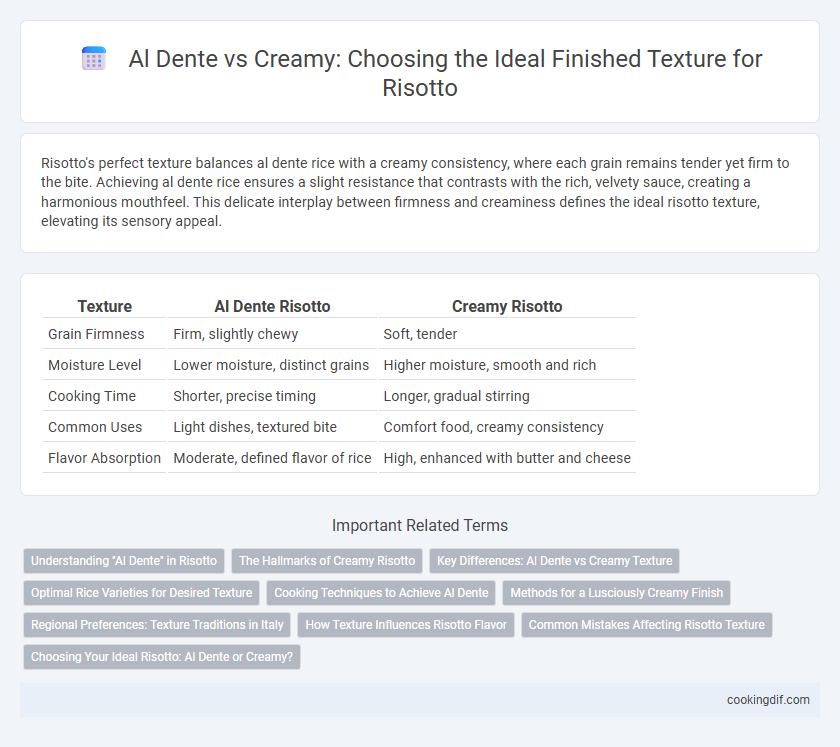Risotto's perfect texture balances al dente rice with a creamy consistency, where each grain remains tender yet firm to the bite. Achieving al dente rice ensures a slight resistance that contrasts with the rich, velvety sauce, creating a harmonious mouthfeel. This delicate interplay between firmness and creaminess defines the ideal risotto texture, elevating its sensory appeal.
Table of Comparison
| Texture | Al Dente Risotto | Creamy Risotto |
|---|---|---|
| Grain Firmness | Firm, slightly chewy | Soft, tender |
| Moisture Level | Lower moisture, distinct grains | Higher moisture, smooth and rich |
| Cooking Time | Shorter, precise timing | Longer, gradual stirring |
| Common Uses | Light dishes, textured bite | Comfort food, creamy consistency |
| Flavor Absorption | Moderate, defined flavor of rice | High, enhanced with butter and cheese |
Understanding "Al Dente" in Risotto
Understanding "Al Dente" in risotto involves achieving rice grains that are tender yet retain a firm, slightly chewy core, providing a desirable bite. The texture contrasts with a fully creamy risotto where grains dissolve more completely into the sauce, creating a softer consistency. Mastering al dente preserves the integrity of Arborio or Carnaroli rice, enhancing both mouthfeel and overall dining experience.
The Hallmarks of Creamy Risotto
Creamy risotto is characterized by its luscious, velvety texture achieved through the gradual addition of warm broth and constant stirring, which releases the rice's starches. The hallmark creaminess comes from the optimal balance between cooked Arborio rice grains that remain slightly firm (al dente) yet meld seamlessly with the sauce. This rich consistency is essential to traditional Italian risotto, providing a smooth mouthfeel without compromising the rice's structural integrity.
Key Differences: Al Dente vs Creamy Texture
Al dente risotto features rice grains that remain firm and slightly chewy, emphasizing texture and individual grain separation, while creamy risotto is characterized by a soft, almost velvety consistency with rice grains more fully cooked and melded together. The key difference lies in cooking time and liquid absorption: al dente results from shorter cooking and less liquid, preserving the grain's structure, whereas creamy risotto involves longer cooking and gradual stirring, encouraging starch release for a cohesive, rich mouthfeel. This contrast shapes the overall sensory experience and pairs differently with ingredients, with al dente suited for dishes needing textural contrast and creamy preferred for comfort and smoothness.
Optimal Rice Varieties for Desired Texture
Arborio rice, with its high starch content, is ideal for achieving a creamy risotto texture, while Carnaroli provides a balance of creaminess and firmness, perfect for an al dente finish. Vialone Nano rice offers superior absorption and creaminess, favored in traditional risotto recipes requiring a delicate, smooth consistency. Choosing the right rice variety directly influences the finished texture, ensuring the desired al dente bite or rich creaminess in every serving.
Cooking Techniques to Achieve Al Dente
Achieving the perfect al dente risotto requires precise control of cooking time and continuous stirring to release the rice's starch slowly, preserving a firm core while creating a smooth exterior. Gradually adding hot broth in small increments allows the grains to cook evenly without becoming mushy, enhancing the contrast between the tender outer layer and slightly resistant center. Using Arborio or Carnaroli rice varieties ensures optimal absorption and texture balance essential for a traditional al dente finish.
Methods for a Lusciously Creamy Finish
Achieving a lusciously creamy risotto requires gradual addition of warm broth combined with continuous stirring, which helps release the rice's starches to create a velvety texture without overcooking the grains. Selecting high-starch varieties like Arborio or Carnaroli ensures a balance between an al dente bite and smooth creaminess. Finishing with a generous amount of butter and freshly grated Parmesan cheese enhances the richness, producing a perfectly textured risotto that maintains slight firmness inside while delivering a decadent, creamy mouthfeel.
Regional Preferences: Texture Traditions in Italy
Northern Italy favors al dente risotto with firm, distinct grains that highlight the rice's structure, reflecting culinary traditions valuing texture precision. In contrast, Southern Italy prefers a creamy finish, achieved through extended stirring and ample use of broth, emphasizing a comforting and rich mouthfeel. These regional preferences illustrate the diverse cultural approaches to risotto texture across Italy.
How Texture Influences Risotto Flavor
Al dente risotto offers a firmer bite that enhances the individual grain's nutty flavor, creating a more textured and lively taste experience. Creamy risotto melds starches and liquid to produce a smooth, rich mouthfeel that accentuates the dish's comforting, buttery notes. Texture directly influences flavor perception, with al dente emphasizing contrast and creaminess highlighting depth and indulgence.
Common Mistakes Affecting Risotto Texture
Overcooking risotto causes the grains to lose their al dente firmness, resulting in a mushy texture that compromises the dish's ideal bite. Using insufficient stirring or incorrect liquid ratios often leads to a lack of creaminess, as the natural starches fail to release properly. Avoiding these common mistakes ensures a perfect balance between the creamy consistency and the slightly firm, al dente rice grains essential to authentic risotto.
Choosing Your Ideal Risotto: Al Dente or Creamy?
Choosing your ideal risotto texture revolves around personal preference and cooking technique, with al dente offering a firm, slightly chewy bite that highlights the grain's integrity, while creamy risotto delivers a rich, velvety consistency achieved by slow stirring and gradual liquid absorption. Arborio and Carnaroli rice varieties are preferred for their starch content, which directly impacts the creaminess of the dish. Mastering the balance between liquid ratio and cooking time determines whether the finished risotto leans towards a textured al dente or a smooth, luscious creaminess.
Al dente vs Creamy for finished texture Infographic

 cookingdif.com
cookingdif.com